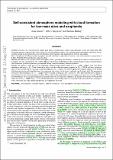Files in this item
Self-consistent atmosphere modeling with cloud formation for low-mass stars and exoplanets
Item metadata
| dc.contributor.author | Juncher, Diana | |
| dc.contributor.author | Jørgensen, Uffe G. | |
| dc.contributor.author | Helling, Christiane | |
| dc.date.accessioned | 2018-01-04T12:30:11Z | |
| dc.date.available | 2018-01-04T12:30:11Z | |
| dc.date.issued | 2017-12 | |
| dc.identifier | 251875278 | |
| dc.identifier | 5a26951f-d478-4046-bd02-fcb6b50b3d1d | |
| dc.identifier | 85038209286 | |
| dc.identifier | 000417620200004 | |
| dc.identifier.citation | Juncher , D , Jørgensen , U G & Helling , C 2017 , ' Self-consistent atmosphere modeling with cloud formation for low-mass stars and exoplanets ' , Astronomy and Astrophysics , vol. 608 , A70 . https://doi.org/10.1051/0004-6361/201629977 | en |
| dc.identifier.issn | 0004-6361 | |
| dc.identifier.uri | https://hdl.handle.net/10023/12426 | |
| dc.description | ChH highlight financial support of the European Community under the FP7 by the ERC starting grant 257431. | en |
| dc.description.abstract | Context. Low-mass stars and extrasolar planets have ultra-cool atmospheres where a rich chemistry occurs and clouds form. The increasing amount of spectroscopic observations for extrasolar planets requires self-consistent model atmosphere simulations to consistently include the formation processes that determine cloud formation and their feedback onto the atmosphere. Aims. Our aim is to complement the Marcs model atmosphere suit with simulations applicable to low-mass stars and exoplanets in preparation of E-ELT, JWST, PLATO and other upcoming facilities. Methods. The Marcs code calculates stellar atmosphere models, providing self-consistent solutions of the radiative transfer and the atmospheric structure and chemistry. We combine Marcs with a kinetic model that describes cloud formation in ultra-cool atmospheres (seed formation, growth/evaporation, gravitational settling, convective mixing, element depletion). Results. We present a small grid of self-consistently calculated atmosphere models for Teff = 2000-3000 K with solar initial abundances and log(g) = 4:5. Cloud formation in stellar and sub-stellar atmospheres appears for Teff < 2700 K and has a significant effect on the structure and the spectrum of the atmosphere for Teff < 2400 K. We have compared the synthetic spectra of our models with observed spectra and found that they fit the spectra of mid-To late-Type M-dwarfs and early-Type L-dwarfs well. The geometrical extension of the atmospheres (at τ = 1) changes with wavelength resulting in a flux variation of ∼ 10%. This translates into a change in geometrical extension of the atmosphere of about 50 km, which is the quantitative basis for exoplanetary transit spectroscopy.We also test Drift-Marcs for an example exoplanet and demonstrate that our simulations reproduce the Spitzer observations for WASP-19b rather well for Teff = 2600 K, log(g) = 3:2 and solar abundances. Our model points at an exoplanet with a deep cloud-free atmosphere with a substantial day-night energy transport and no temperature inversion. | |
| dc.format.extent | 17 | |
| dc.format.extent | 1477020 | |
| dc.language.iso | eng | |
| dc.relation.ispartof | Astronomy and Astrophysics | en |
| dc.subject | Astrochemistry | en |
| dc.subject | Methods: numerical | en |
| dc.subject | Radiative transfer | en |
| dc.subject | Stars: atmospheres | en |
| dc.subject | Stars: low-mass, brown dwarfs | en |
| dc.subject | QB Astronomy | en |
| dc.subject | Astronomy and Astrophysics | en |
| dc.subject | Space and Planetary Science | en |
| dc.subject | NDAS | en |
| dc.subject.lcc | QB | en |
| dc.title | Self-consistent atmosphere modeling with cloud formation for low-mass stars and exoplanets | en |
| dc.type | Journal article | en |
| dc.contributor.sponsor | European Research Council | en |
| dc.contributor.institution | University of St Andrews. St Andrews Centre for Exoplanet Science | en |
| dc.contributor.institution | University of St Andrews. School of Physics and Astronomy | en |
| dc.identifier.doi | https://doi.org/10.1051/0004-6361/201629977 | |
| dc.description.status | Peer reviewed | en |
| dc.identifier.url | https://arxiv.org/abs/1708.06976 | en |
| dc.identifier.grantnumber | 257431 257431 | en |
This item appears in the following Collection(s)
Items in the St Andrews Research Repository are protected by copyright, with all rights reserved, unless otherwise indicated.

